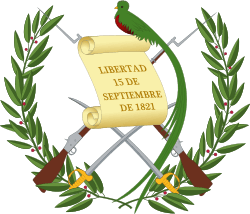Guatemalan Spanish
| Spanish language |
|---|
| Overview |
| Grammar |
Guatemalan Spanish is the national variant of Spanish spoken in the Central American republic of Guatemala. About 13.7 million of the 16 million population speak Spanish. It includes the use of the second-person singular personal pronoun vos alongside the standard Spanish second-person singular pronouns tú and usted to form a three-level system of second-person singular address,[1] all of which would be translated as "you" in English.
Phonetics and phonology
- The presence of Seseo wherein /s/ and /θ/ are pronounced as [s]. Seseo is common to Andalusian and Canarian Spanish varieties.
- Syllable-final /s/ is realized as glottal [h][2][3]
- /x/ is realized as glottal [h].[2][3]
- The pronunciation of intervocalic /j/ (orthographic y or ll) is "weak", without friction.[2][3]
- Intervocalic /d/ often disappears; the ending -ado is often [ao].[2][3]
- There is no confusion between /l/ and /r/, as in the Caribbean.
- Word-final /n/ is pronounced velar [ŋ].[2][3]
- As Guatemala was part of First Mexican Empire, Guatemalan dialect adopted the voiceless alveolar affricate [t͡s] and the cluster [tl] (originally /tɬ/) represented by the respective digraphs <tz> and <tl> in loanwords of Nahuatl origin, quetzal and tlapalería [t͡ɬapaleˈɾia] ('hardware store'). Even words of Greek and Latin origin with <tl>, such as Atlántico and atleta, are pronounced with the affricate: [aˈtlãn̪t̪iko̞], [aˈtle̞t̪a] (compare [aðˈlãn̪t̪iko̞], [aðˈle̞t̪a] in Spain and other dialects in Hispanic America[4]).
Vocabulary
A number of words widely used in Guatemala which have Nahuatl, Mayan or other native origins, in particular names for flora, fauna and toponyms. Some of these words are used in most, or all, Spanish-speaking countries, like chocolate and aguacate ("avocado"), and some are only used in Mexico and most Central American countries, like Guatemala and El Salvador. The latter include guajolote "turkey" < Nahuatl huaxōlōtl [waˈʃoːloːt͡ɬ] (although pavo is also used, as in other Spanish-speaking countries); papalote "kite" < Nahuatl pāpālōtl [paːˈpaːloːt͡ɬ] "butterfly"; and jitomate "tomato" < Nahuatl xītomatl [ʃiːˈtomat͡ɬ]. For a more complete list see List of Spanish words of Nahuatl origin. Local words include
- chapín – Guatemalan
- chish - interjection signifying disgust[5]
- cincho - belt
- chucho - dog
- chumpa - jacket
- canche – blonde(not used in all of Guatemala)
- cabal – right on
- colocho - curly (usually when speaking of hair)
- ishto - kid (brat) (not used in all of Guatemala, varies from regions)
- mosh - oat porridge (not used in all of Guatemala, more formally used and said is "avena")
- patojo – child (young people)
- pisto - money
- pajilla - straw
- poporopo - popcorn
- shuco - dirty (not to be confused with a type of hot-dog of the same name native only to Guatemala City)
There are also many words unique to Central America, for example, chunche or chochadas or babosadas means "thing" or stuff in some places. The words used to describe children (or kids) vary among the countries in Central America; in Guatemala they are often called patojos. Cipotes is also used in Guatemala in the eastern departments. In the western and northern departments of Guatemala "chamacos" is used to say children or kids. In Guatemala and Honduras the word güiros is also used. In Guatemala (also in Honduras and El Salvador) money is called pisto, a term originally used by Maya peoples in Guatemala.[6]
See also
Notes
- ↑ Pinkerton 1986, p. 690.
- 1 2 3 4 5 D. Lincoln Canfield, Spanish Pronunciation in the Americas (University of Chicago Press, 1981), pp. 65-66.
- 1 2 3 4 5 John M. Lipski, Latin American Spanish (Longman, 1994), pp. 290-291.
- ↑ Navarro Tomás (2004)
- ↑ Online dictionary of the Real Academia Española (Spanish)
- ↑ Honduras slang
References
- Acevedo-Halvick, Ana (June 2006). "Cortesía verbal (introducción)" (PDF). Voces. Universidad Rafael Landívar. 1: 21–71.
- Pinkerton, Anne (September 1986). "Observations on the Tu/Vos Option in Guatemalan Ladino Spanish". Hispania. American Association of Teachers of Spanish and Portuguese. 69 (3): 690–698. doi:10.2307/342783.
- Predmore, Richard L. (1952). "El sufijo-al en el español de Guatemala" (PDF). Nueva Revista de Filología Hispánica. 6 (2): 140–144. Retrieved 2010-05-04.
- Toursinov, Antón (2001). "Lexical peculiarities of Guatemalan national variant of Spanish" (PDF). Intercultural Communication. Chelyabinsk State University: 143–150.
- Toursinov, Antón (October 2002). "Stylistic variability of pronoun addresses in modern Spanish of Guatemala". Language and Literature. Tyumen State University. 17 (3).
- Utgård, Katrine (2006). Fonética del español de Guatemala Análisis geolingüístico pluridimensional (MA thesis) (PDF). University of Bergen.
